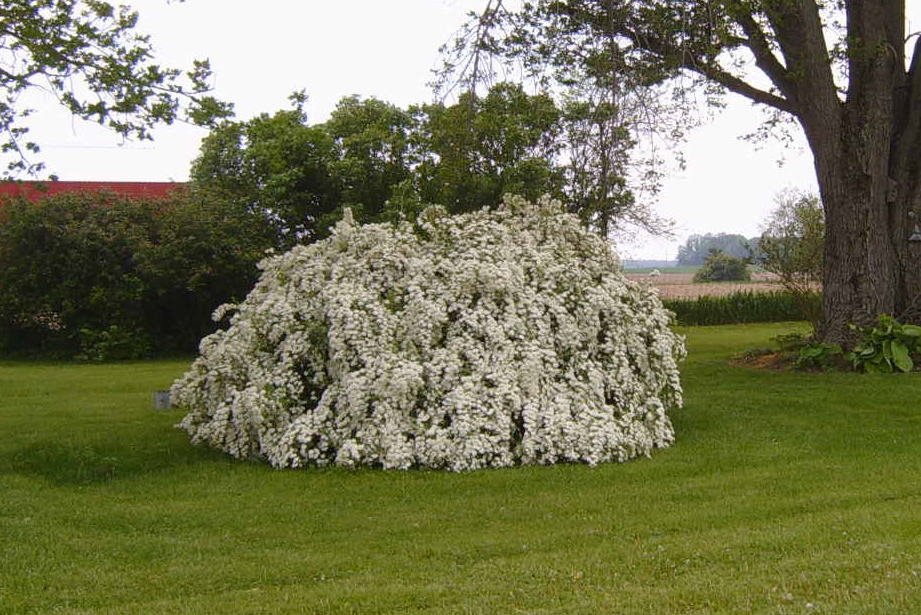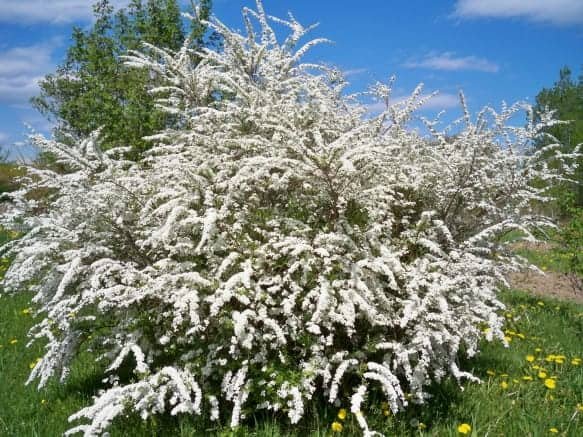Bridal Wreath Spirea is a common name for two different Spirea shrubs, Spiraea prunifolia and a hybrid, Spiraea x vanhouetti. They both have a similar shape with beautiful white cascading flowers.
This is a perfect case for learning to use scientific names for plants because of the growing habits of each species and the difference in how invasive each one is.

© Suzie Browning

Source: Rhonda Tardiff -CC0
As a general rule, Bridal Wreath Spirea is not invasive. It is not listed on any state or national invasive species lists or law. However, there are counties in the United States where it has been reported as invading natural areas. This includes counties in 21 states for Spiraea prunifolia but only 1 county in Michigan for Spiraea x vanhouttei.
Simply put, prunifolia can be invasive in some areas, vanhouttei is unlikely.
The reported records are for natural areas which include national parks, roadsides, or abandoned homesteads.
In your tended garden, you should not have a problem with either shrub taking over or spreading out of control.
After identifying which Bridal Wreath Spirea you have, you can check the maps and table below to see if your species has been reported in your county.
It is possible conditions in those areas might be favorable for more robust growth and spreading. If your county is listed and you have any doubts about planting Bridal Wreath Spirea, check with your local county extension agent for advice.
Table of Contents
Spiraea Prunifolia (Old-fashioned Bridal Wreath)
Bridal Wreath is a non-native, fast-growing shrub and spreads by new basal shoots from the roots near the base. You can help control the spread by cutting off those shoots.

| STATE | COUNTIES |
|---|---|
| Alabama | Bibb, Butler, Lauderdale, Monroe,Tuscaloosa |
| Arkansas | Franklin |
| Connecticut | Fairfield, Hartford, Litchfield, New Haven, New London |
| D. of Columbia | Disctrict of Columbia |
| Illinois | DuPage, Jackson, Kankakee, Williamson |
| Indiana | Crawford, Greene, Harrison, Lawrence, Spencer, Vermillion |
| Kentucky | Breckinridge, Bullitt, Fulton, Hickman, Jessamine, Lyon, Trigg |
| Louisiana | Bienville, East Baton Rouge, Grant, Jefferson, Lincoln, Ouachita, Richland, Tensas, Union, Webster |
| Maryland | Montgomery, Prince George’s |
| Massachusetts | Barnstable, Bristol, Middlesex, Suffolk |
| Mississippi | Calhoun, Grenada, Lafayette, Yalobusha |
| Missouri | Cole, Jefferson, Lewis, Lincoln, Newton |
| New Jersey | Atlantic, Burlington, Camden, Cumberland, Gloucester, Monmouth, Ocean, Salem |
| New York | Nassau, Orange, Putnam, Rensselaer, Rockland, Ulster |
| North Carolina | Buncombe, Guilford, Halifax, Jackson, Macon, Moore |
| Ohio | Adams, Ashtabula, Cuyahoga, Highland, Knox |
| Pennsylvania | Allegheny, Bedford, Blair, Bucks, Cumberland, Huntingdon, Juniata, Lehigh, Perry, Westmoreland |
| Rhode Island | Washington |
| Tennessee | Anderson, Carroll, Claiborne, Giles, Hancock, Henderson, Henry, Johnson, Morgan, Roane, Rutherford, Shelby, Stewart, Van Buren |
| Texas | Madison |
| Virginia | Amherst, Augusta, Bedford, Caroline, Culpeper, Fairfax, Fauquier, Fluvanna, Gloucester, Greene, James City, Lancaster, Loudoun, Nelson New Kent, Nottoway, Prince Edward, Rockbridge |
| West Virginia | Hancock, Jackson, Marion, Webster, Wood |
Spiraea x vanhouttei (Vanhoutte Spirea)
Only one county in the state of Michigan in the whole United States has reported the VanHoutte Spirea as invasive.
2 out of 3 records for the sightings in Gogebic, Michigan report they were abandoned plantings. We know Burpee offered this shrub for sale in 1888. Without knowing when they were planted, we could speculate they could be up to 130 years old.
Given that they are fast growers, one Vanhoutte spirea shrub with plenty of age, can grow quite large and overtake natural plants.
The size of these plantings may be the sole reason they were listed as invasive. In my zone 6 garden, my 30+-year-old shrub is over 16 feet wide and 9.5 feet tall.

How to Control an Invasive Spirea
Old-fashioned Bridal Wreath Spirea spreads by suckering. Suckering is when a plant sends out new shoots from the roots generally somewhere near the base.
Remove New Basal Shoots
You can help control the spread by cutting off those new shoots. I try to cut them just under the soil surface.
Spray with a Herbicide
If you would like to use a chemical, you must disconnect the shoots from the main shrub first. Otherwise, the poison will travel to it too. That might not totally kill your shrub but it can do some serious damage.
To disconnect the shoots from the main shrub, use a shovel in a circle around the base of the shrub, making sure you go deep. This method is called root pruning and works well for a couple of other situations, like encouraging growth and transplanting shoots of desirable shrubs.
Don’t Prune
Pruning the top of a plant sends the energy of those cut-off stems to other areas and encourages growth elsewhere, like suckers.
To avoid needing to prune a shrub to fit it’s location, make sure when first planting to match the location to a shrub. The natural forms of many shrubs are much more beautiful than ones cut back to fit a space.
Transplant The Shrub
If your Bridal Wreath Spirea is growing out of control that means it is happy! If it’s not too large, move it to a different location where it gets less light and less water.
